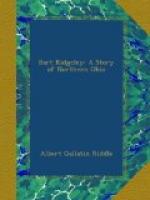The young advocate clearly opened out the nature of the defence of adverse possession, and the philosophy upon which it rested; and explained that the defendant, to meet the plaintiff’s paper case, must show that he and those under whom he claimed, had been in the open, continued, and notorious possession of the property for twenty years, before suit was brought, claiming to be the owners. This the defendant was to show, at the peril of destruction; and in a few happy sentences he brought the jury to feel an intense anxiety that he should succeed.
Then he turned back the years, blotted out the highways, re-planted the forests, till the court house dissolved, and a wondrous maple wood crowned the hill on which it stood. And so back, till the Indians returned, and elk and panthers roamed at will. Then he pointed out a sorrow-stricken, moody, brooding man, seeking a “lodge in the vast wilderness,” hunting the spring, and building his shanty, making his clearing, and planting a few apple seeds, brought from his old home; and picking up the section of the tree trunk, he read off from its end, “twenty-nine years ago!”
He sketched in rapid, natural lines, the life of the recluse, the necessities of his situation, his keeping cows, and the means of restricting their range; dwelt upon the evidence of the tree fences, and argued that the fact that two of them were used for that purpose, was conclusive that the other sides were also fenced, for without them no enclosure could exist. And he referred to the well known universal custom of that early day.
Lord! how those old and somewhat mythical tree fences grew, and came out under his hands! The hunters had herded elk in their angles; bears had been trapped in their jungles; the doe hid her fawn in their recesses; wolves and foxes had found lairs in them; birds had built nests in them; men in search of strayed cattle had climbed upon them to listen for the tinkling bell; balm and thyme, wild sun-flowers and celandine had made them fragrant with perfume, and bright with color.
Basil Hall went to that spring, and built and occupied, because he owned it. His very settlement and occupancy was a proclamation of ownership—an assertion of right—the most satisfactory, and so the Court would say. Here he read from the Ohio Reports, to show that a parol claim, without any written color of title, was sufficient to make the claim. He then referred to the evidence of Bullock, that Hall did by word claim such right; that the claim was acknowledged by Cole, who bought and paid for it. If Hall had been without claim of right, Cole would have turned him out; but he acknowledged it, bought, got it, and held it. The word of Ward could not be taken; he was interested; if taken, it could not be believed; if believed, it proved nothing, for the admission of Hall to him, that he had no right, was made after Hall had sold out, and hence not evidence against the purchaser, all of which he forcibly illustrated; and the proposition was conceded to be law. He claimed that this defence under the purchase from Hall, was perfect in itself.




